GMO Food Labeling: GMO foods are those changed by scientists to be better. They might be changed to grow faster or not get sick. But how can you know if your food has GMOs? Let’s find out!
What is GMO Labeling?
Labels tell us if food has GMOs. In the U.S., GMO Food Labeling might say “bioengineered” on the package. In Europe, it will say “genetically modified” or “made from genetically modified [name of the organism]”.GMO labeling requirements
GMO labeling requirements
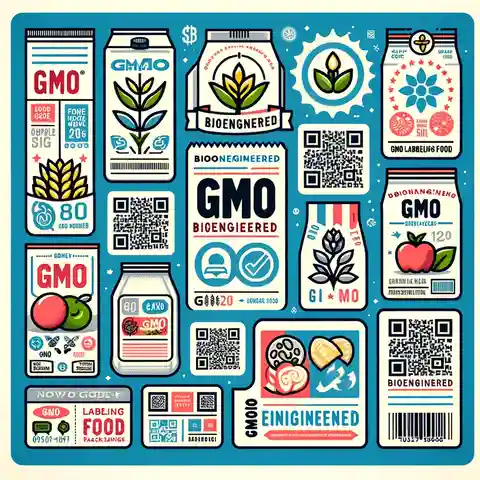
There are rules about telling people if their food has GMOs (Genetically Modified Organisms). Here’s a simple way to understand these rules:
- Bioengineered Labels:If a food has GMOs in the U.S., the label must say “bioengineered” or have a special symbol. This helps people know what’s in their food.
- What Needs Labels:Not all foods need these labels. For example, if a food has only a bit of GMO, like some oils or sugars, it might not need a label. Also, meat, poultry, eggs, and food sold in restaurants usually don’t need a GMO label.
- How Labels Can Look:The label can be just text on the packaging, a special symbol, or even a Q.R. code you can scan with a phone to get more information.
- Why Have These Rules:The idea is to allow people to choose what they want to eat. Some people like to avoid GMOs, and others don’t mind.
These rules are meant to make it easy for everyone to understand what’s in their food, whether shopping in a store or choosing what to eat.
GMO Food Labeling Pros and Cons
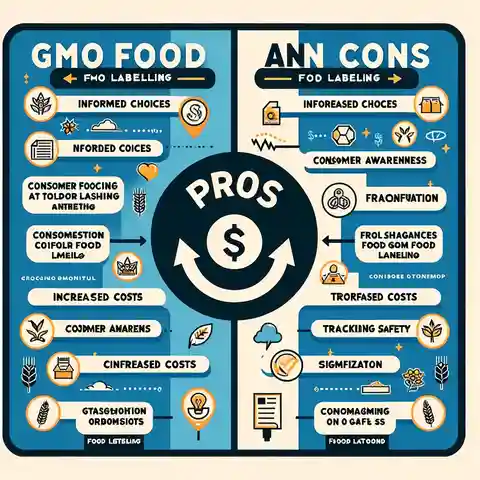
When we talk about labeling GMO (Genetically Modified Organism) foods, there are good things and not-so-good things about it. Let’s make it simple to understand:
Pros of GMO Labeling:
- Knowing More:Labels tell us if food has GMOs.
- Being Safe:Labels can help track if GMOs are safe and keep our food healthy.
- Making Choices:People who eat certain ways, like vegans, can choose better with labels.
- Matching Other Countries:Many places worldwide label GMO foods.
Cons of GMO Labeling:
- Confusion:Some people might need help understanding what GMO means. This can make them worried or confused about their food.
- Costing More:Making new labels for food can make food cost more money.
- Making Foods Seem Scary:Sometimes, labels can make people think GMO foods are bad, even when they’re not.
- We Already Have Choices:There are already foods without GMOs. Some people think we don’t need labels.
So, labeling GMO foods has its ups and downs. Whether food has GMOs or not, it’s all about eating healthy and what’s best for you!
5 products with GMO labels
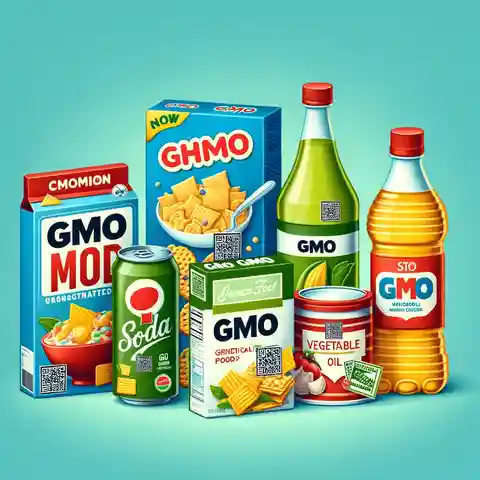
Here are five products that often have GMO labels explained:
- Cereals with Corn or Soy:Many cereals are made with corn or soy. Many corn and soybeans are GMO, so that these cereals might have a GMO label.
- Snack Foods:Snacks like chips or crackers sometimes have corn, soy, or canola oil. These oils can be from GMO plants, so that you might see a GMO label on these snacks.
- Soda and Sweet Drinks:These drinks often have sweeteners like corn syrup. Corn syrup can be made from GMO corn, so that these drinks could have a GMO label.
- Processed Foods:Foods like frozen pizzas or microwave meals often have many ingredients, including oils and sweeteners from GMO plants. These kinds of foods might have a GMO label, too.
- Vegetable Oils:Oils like canola, soybean, and corn oil are often made from GMO plants. That’s why bottles of these oils usually have GMO labels.
GMO labels help us know if something in our food was made using GMO plants. But remember, just because a food has a GMO label doesn’t mean it’s bad. It’s just made with ingredients that are a little different.
What is the GMO labeling law?
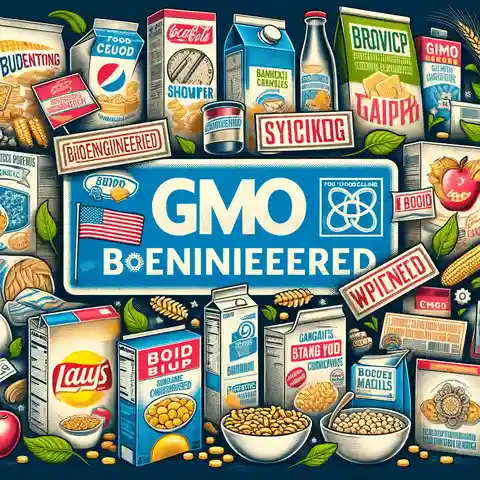
GMO Labeling Law:
- S.Law: In the U.S., the National Bioengineered Food Disclosure Standard requires certain foods to disclose if they are bioengineered. This law helps people know if their food has GMO ingredients.
- Label Forms:The law says you can use text, symbols, or electronic links to show if a food is bioengineered.
What countries require GMO labeling in foods?
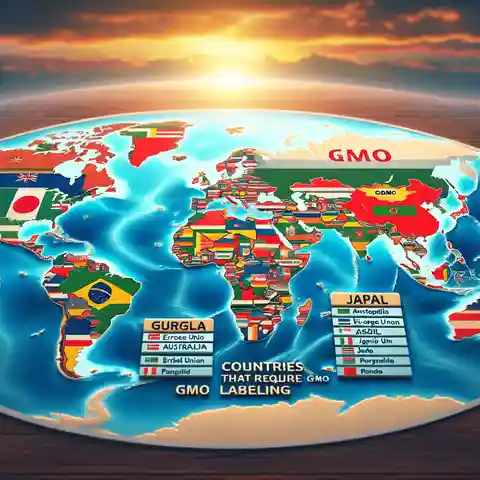
Countries That Require GMO Labeling:
- Many Countries:Over 60 countries, including those in the European Union, Australia, Brazil, China, Japan, and Russia, have laws for GMO food labeling.
- Different Standards:Each country has its own rules. Some require labels for all GMO foods, while others have specific guidelines on what needs to be labeled.
How do you identify GMO foods?
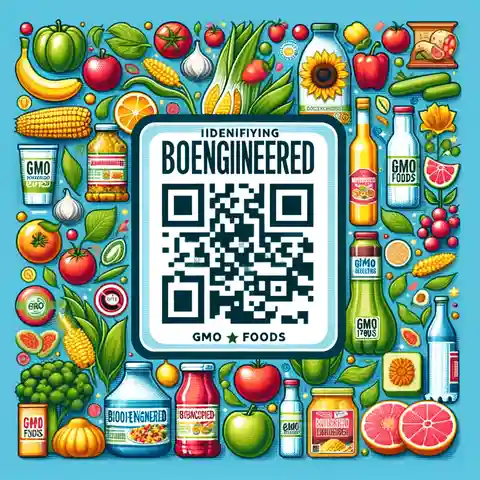
Identifying GMO Foods:
- Look for Labels:In some places like the U.S., foods with GMOs must have a label. These labels might say “bioengineered” or have a special symbol.
- Q.R.Codes:Some products use Q.R. codes. Scan them with a smartphone to find out if the food has GMOs.
- Check Ingredients:Foods with corn, soy, canola, and cottonseed often have GMOs, as these crops are commonly genetically modified.
What’s Bioengineered?
Bioengineered means the food has GMOs. Lots of everyday foods, like corn and soybeans, are often bioengineered. Here’s a simple way to understand it:
What Does Bioengineered Mean?
Bioengineered foods have had some of their parts changed by scientists.
This change is usually done to make the food grow better, resist diseases, or stay fresh longer.
Common Bioengineered Foods:
Many everyday foods, like corn and soybeans, are often bioengineered.
This means they have been changed to improve them somehow.
Bioengineered foods are just like regular foods, but with some small changes to make them better in certain ways.
New Rules for Labeling GMO Foods:
In 2022, the United States introduced new rules for labeling foods with GMOs (Genetically Modified Organisms). Here’s a simple explanation:
Bioengineered Labels:
Foods with GMOs must now say “bioengineered” on their labels.
This new term helps people know if the food has GMOs.
Exceptions to the Rule:
Not all foods need this label. For example, meat products might not always have a “bioengineered” label.
This is because of specific rules about what types of food need these labels.
How Are GMO Labels Checked?
If you think a food label about GMOs is not right, you can do something about it:
- Tell the USDA:
The USDA (U.S. Department of Agriculture) oversees these labels.
If you see a label you think is wrong, you can tell the USDA.
- What Happens Next:
The USDA will check to see if the label is correct.
They make sure that all the rules about labeling are followed.
So, the new rules help people know more about GMOs in their food. And if there’s a mistake, the USDA can check and fix it.
Restaurants and GMOs: Easy to Understand
When you visit a restaurant, they sometimes tell you if their food has GMOs (Genetically Modified Organisms). Here’s a simple way to understand this:
Eating Out and GMOs:
In restaurants, foods don’t have to say if they have GMOs.
This means you won’t see a label when you order food at a restaurant like you do on food in a store.
Why Restaurants Are Different:
It’s harder for restaurants to label foods with GMOs. They make lots of different dishes and change their menus often.
Different rules apply to restaurants than places that make and sell food in stores.
Why Do Foods Have GMO Labels?
Having labels on foods in stores that tell you about GMOs is important. Here’s why:
- Making Choices:
Labels help you decide what to eat. If you want to avoid GMOs or don’t mind them, labels give you the information to choose.
- Different Opinions:
People think differently about GMO foods. Some are okay with eating them, and others aren’t. Labels help everyone know what’s in their food.
- Knowing What’s in Your Food:
Labels make it clear what’s in the food you buy.
So, in stores, you’ll find labels on food packages to help you know if they have GMOs. But in restaurants, they don’t usually tell you about GMOs in the food.
How Are GMOs Checked in the U.S.?
In the United States, three big groups check GMOs (Genetically Modified Organisms) to ensure they are safe. Let’s see how they do it:
- U.S.Food and Drug Administration (FDA):
The FDA looks at foods for people and animals, including those with GMOs.
They check to ensure these foods are as safe as foods that don’t have GMOs.
They set rules for food safety and make sure everyone follows them, no matter how the food is made.
- U.S.Environmental Protection Agency (EPA):
The EPA takes care of our health and the world around us.
They check the safety of special stuff in GMO plants that protect them from bugs and diseases.
The EPA also watches all pesticides used on farms, whether on GMO or non-GMO crops.
- U.S.Department of Agriculture (USDA):
The USDA ensures GMO plants are safe and won’t harm other plants.
They have rules and services focusing on GMOs and how they affect farming.
These groups work together to make sure GMOs are okay to eat and won’t hurt people, plants, or animals. They do a lot of tests and studies to be sure everything is safe.
Which Foods Need GMO Labels?
Not every food with GMOs (Genetically Modified Organisms) has to tell you about it on the label. Here’s why:
- Small GMO Parts:
If a food has just a bit of GMO, like in some sugars and oils, it might not need a label.
This is because when GMO plants like corn are made into oils or syrup, the GMO part is so small it’s hard to find.
- Special Rules:
There are rules about which foods need GMO labels. These rules can be different in different places.
For example, the U.S., the rule says that if you can’t find the GMO part in the final food, it doesn’t need a label.
- Labeling Choices:
Sometimes, companies choose to tell you about GMOs even if they don’t have to. They might label it “Derived From Bioengineering” or something similar.
- Why Not Everything Is Labeled:
Labeling every little GMO part can be hard and costly. So, the rules focus on foods where the GMO part is bigger and easier to find.
Remember, not seeing a GMO label doesn’t always mean no GMO. It could just be a small part that’s not easy to find.
Are GMO Foods Safe?
Big health groups, like the U.S. Food and Drug Administration (FDA) and the World Health Organization (WHO), have studied GMO foods. They say eating GMO foods is safe, just like eating other foods. Here’s a bit more about that:
- What Do the Big Health Groups Say?
The FDA and WHO are like doctors for our food. They check and ensure that our food is good for us.
These groups have looked at GMO foods very carefully. They’ve done a lot of tests and studies.
After all their work, they say that GMO foods are safe to eat.
- What are GMO Foods?
GMO stands for “Genetically Modified Organisms.” It’s a fancy way of saying that scientists have changed the food a little, using science, to make it grow better or stay fresh longer.
This can include making a fruit or vegetable that doesn’t get sick easily or growing faster.
- Why Do We Need to Know?
Some people like to know if their food is GMO because they want to understand what they eat.
Knowing about GMOs helps people make choices about their food. Some might prefer GMO foods, and some might choose other kinds.
- Labels Help Us Choose
In many places, foods that have GMOs in them have labels. This helps everyone know what they’re buying.
So, GMO foods? They’re just like other foods but with some science added. The experts say they’re safe, and labels help us choose what we eat.
For more detailed information, you can check out the sources from the FDA and WHO.




